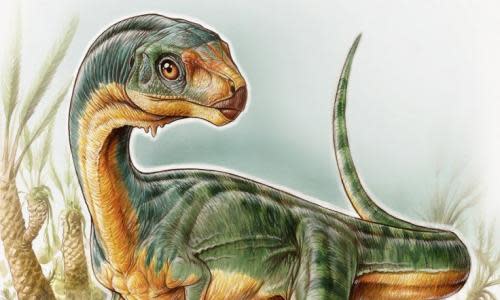Chilesaurus is the dinosaur discovery of the century | Brian Switek

Chilesaurus doesn’t look like the kind of dinosaur that would kick up much of a fuss. The Jurassic saurian – named for the country, not the tasty peppers – was a small, bipedal herbivore that munched on plants over 150m years ago. It didn’t have nasty teeth, crazy horns, or the immense body size that typically launch the careers of Mesozoic celebrities. The creature’s secret is more subtle, and plays into a controversial reshuffling of the dinosaur family tree.
When Chilesaurus was announced to the public in 2015, the dinosaur was characterised as one of the theropods: this is the major dinosaur family that includes famed species such as Tyrannosaurus and Velociraptor. But, even though theropods were long characterised as “the carnivorous dinosaurs”, in recent years paleontologists have recognised that this group contained a fair number of species that gave up the meat-eating ways of their ancestors to become omnivores and herbivores, too. Chilesaurus seemed to be one of these evolutionary flips – a herbivorous dinosaur that had evolved from carnivorous ancestors.
But now paleontologists Matthew Baron and Paul Barrett offer a different view of Chilesaurus. Instead of simply being a weirdo theropod, this strange dinosaur could be a connecting point between two dinosaur groups that were previously thought to be vastly different and only distantly related. It’s a keystone in a new dinosaurian arrangement. Understanding the significance of Chilesaurus requires a crash course in dinosaur systematics. I’ll try to make this as painless as possible.
In the traditional scheme that has stood for over a century, dinosaurs are divided into two major subgroups. One branch – the saurischians – is made up of the theropods and sauropodomorphs. Think Brachiosaurus and its relatives. The other branch – the ornithischians – includes the armoured dinosaurs, horned dinosaurs, duckbilled dinosaurs, and their varied kin. Hip shape is the key to the division. But then Baron and Barrett shook things up.
In their new scheme, published earlier this year, Baron, Barrett, and David Norman suggested that the traditional groupings were mixed up. In the new analysis, the ornithischian and theropod dinosaurs – previously thought to be only distant relatives – actually came out as closely allied lineages in a group the researchers call Ornithoscelida. The sauropod dinosaurs and a group of early carnivorous dinosaurs called herrerasaurids, on the other hand, become the new members of the Saurischia.
Think of it this way. Tyrannosaurus and Triceratops were previously thought to be about as distantly related to each other as it was possible for dinosaurs to be. The new family tree brings them closer together, sharing a nearer common ancestor with each other than either did with the forerunners of Brontosaurus.
Enter Chilesaurus. In a new Biology Letters paper, Baron and Barrett propose that Chilesaurus bridges the anatomical gap between the theropod and ornithischian dinosaurs. This would explain why the dinosaur looks so strange for a relative of Allosaurus and company – it shared a close common ancestor with theropods but had traits like a beak at the tip of its snout and features of the hip that put it closer to the origins of the group that includes the likes of Stegosaurus and Parasaurolophus. Chilesaurus, in other words, could be a transitional form – a dinosaur with a mosaic of characteristics that underscores Baron and Barrett’s revised family tree.
Our favourite dinosaurs are still as impressive as ever, regardless of which group they’re shuffled into
So should we start revising the textbooks and practising the pronunciation of “Ornithoscelida”? That’s difficult to say. The new family tree is still being debated among paleontologists. There are some anatomical details such as air sacs, for example, that are shared by theropod and sauropod dinosaurs but not the ornithischians. In the traditional family tree, this would mean that theropods and sauropods are close relatives, whereas in the new tree air sacs would have had to evolve twice. We currently lack the fossils to know which scenario is correct.
Likewise, the shape of the new family tree rests on the anatomy of some of the earliest dinosaurs and their forerunners, some of which are still head-scratchers themselves. Just this month an animal called Pisanosaurus was demoted from its status as one of the earliest ornithischian dinosaurs to a group of lanky protodinosaurs. The fossils most relevant to the shape of the dinosaur family tree, found in Triassic rocks, are still being uncovered, scrutinised, checked, and reshuffled. And it’s not as if Chilesaurus is the first bizarre, beaky theropod known – Limusaurus from the 160m-year-old rock of China also fits that bill. Caveats and considerations abound.
All this might seem above the pay grade of the casual dinosaur fan. Our favourite dinosaurs are still as impressive as ever, regardless of which group they’re shuffled into. But these big picture arrangements matter for how dinosaurs became the animals that stalk our dreams and nightmares. These relationships offer roadmaps to how dinosaurs evolved into the fantastically disparate forms that have fascinated us since we first uncovered their bones. The debate is far from over, and, though it might sound somewhat sinister of such a meek dinosaur, we haven’t heard the last of Chilesaurus.
• Brian Switek is the author of My Beloved Brontosaurus and Written in Stone, and the host of Dinologue.com

 Yahoo News
Yahoo News 